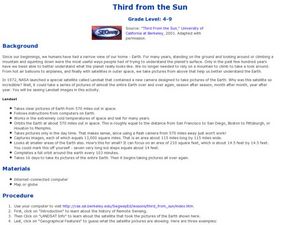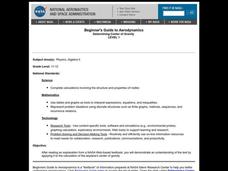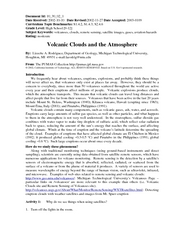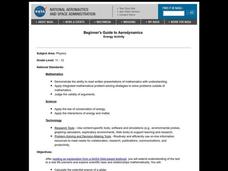Curated OER
Lift/Velocity Relationship Problem Set
Students, after reading an explanation from a NASA Web-based textbook, demonstrate their ability to use, graph (using a graphing calculator), and interpret a text equation.
Curated OER
Vectors in Relative Velocities Problem Set
Students, after reading an explanation from a NASA Web-based textbook, demonstrate an understanding of vector addition and the text by applying them to the determination of vector components and relative velocities.
Curated OER
Size Effects Problem Set
Students, after reading the Size Effects page from a NASA Web-based textbook, demonstrate an understanding of Size Effects by answering questions.
Curated OER
Wind Tunnel Aerodynamics Problem Set
Students, after reading an explanation from a NASA Web-based textbook, demonstrate an understanding of the text by applying it to the calculation of area, velocity, and pressure in a wind tunnel.
Curated OER
Density and Lift
Students, after reading from a NASA Web-based textbook, demonstrate an understanding of the text by solving problems on density and predicting which density give the most lift.
Curated OER
Drag Equation - Level 1
Students, after reading the Drag Equation page from the NASA Web site, demonstrate an understanding of this equation and how drag is dependent on the variables included in the equation.
Curated OER
Drag Equation - Level 2
Students, after reading the Drag Equation page from the NASA Web-based textbook, demonstrate an understanding of this equation and how drag is dependent on the variables included in the equation.
Curated OER
The Lift Equation Problem Set
Students, after reading the Lift Equation page from a NASA Web-based textbook, demonstrate an understanding of the lift equation by answering questions.
Curated OER
Altitude and Flight Forces
Learners use the World Wide Web to access and use FoilSim. They also use the World Wide Web to access the NASA Glenn Web site for information relative to the factors involved with the flight of an airplane.
NASA
Space Shuttle Glider
Your charges will enjoy putting together this model of the space shuttle and completing the three challenge activities described in the lesson. The worksheets embedded in the plan that pupils use to cut out their gliders are beautifully...
Curated OER
Rocket Me into Space
Fourth graders study the concept of thrust and how it propels rockets into space. They discover why airplanes cannot travel into space while considering the engineering techniques use in designing rockets. They look at how space...
Curated OER
Third from the Sun
Students examine images from space. In this third from the Sun lesson, students examine images from, Landsat, the satellite launched by NASA in 1972.
Curated OER
History of Flight Timeline Activity
Scholars are introduced to the significant events that led to the development of today's modern forms of air travel. They create a timeline to identify the vital events that are related to man's flight. In addition, they research various...
Curated OER
Coral Bleaching in the Caribbean
Students practice analyzing images, maps and graphs from Internet-based educational resources. They explore the correlation between sea surface temperature and coral bleaching. Students comprehend that coral reefs are collections of tiny...
Curated OER
Weather Jeopardy
Fourth graders review weather terms by playing a game of Weather Jeopardy.
Curated OER
The Wrights' Flight: History Through Primary Sources
Pupils read primary source material about the Wrights' first flight such as a journal and a telegram. In this The Wrights' Flight lesson, students select the most reliable primary source and compare the pros and cons of using primary...
Curated OER
Determining the Altitude of Iridium Flares
Students examine what iridium flares are and when they occur. In this iridium flare lesson students complete an activity to see how far overhead Iridium satellites are.
Curated OER
Determining Center of Gravity
Students complete calculations involving the structure and properties of matter. They engage in a variety of problem solving activities to help them determine the center of gravity.
Curated OER
Determining Center of Gravity
Students complete calculus calculations involving the structure and properties of matter and determining the center of gravity.
Curated OER
Sand or Rock? Finding Out From 1,000 km
Students observe how measurements are made with different instruments. For this remote sensing lesson students investigate the physical state of surfaces including the surfaces of the solar system.
Curated OER
Volcanic Clouds and the Atmosphere
Students examine how scientists monitor volcanoes. In this volcano lesson plan students complete several activities including why we see things when using satellites.
Curated OER
DEW POINT
Fourth graders investigate conditions causing saturation and measure the dew point of the atmosphere performing simple experiments.
Curated OER
Energy Problem Set
Students calculate the potential energy of a glider, the kinetic energy of a moving glider and the change in velocity when potential energy changes to kinetic energy.
Curated OER
Geometry Problem Set I
Students prove angles congruent by use of vertical angles definition, subtraction postulate, and transitivity postulate.

























